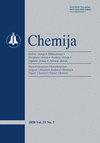Electrochemical exfoliation-streamline method for synthesis of nitrogen doped graphene
IF 0.4
4区 化学
Q4 CHEMISTRY, MULTIDISCIPLINARY
引用次数: 2
Abstract
2 Faculty of Material Science and Applied Chemistry, Riga Technical University, 14/24 Azenes Street, 1048 Riga, Latvia Graphene was discovered in the early 21st century, but has already proven itself in many applications – energy, medicine, electronics, food and sports, and more. Functionalization of nanostructured carbon materials with both non-metallic and metallic atoms is possible in various ways, imparting enhanced or new properties to the starting material, even catalytic activity. A method of electrochemical exfoliation was used to obtain the graphene sheets and simultaneously functionalize them with nitrogen. To ensure N-doping the process is done in a NaN3 electrolyte solution which provides less quantity of oxygen groups that tend to block defect sites on the graphene, compared with such solvents as NaNO2. Two graphite electrodes are inserted into the electrolyte and a pulse power of 0–10V is applied. The solution containing the obtained material is filtered through a 0.1 μm filter and dried. The material is characterized using SEM, XRD and XPS. In the XPS characterization graphene oxide is used as a reference material.电化学剥离-流线法合成氮掺杂石墨烯
2里加技术大学材料科学和应用化学学院,地址:14/24 Azenes Street,1048 Riga,Latvia石墨烯于21世纪初被发现,但已经在能源、医学、电子、食品和体育等许多应用中证明了自己的实力。具有非金属和金属原子的纳米结构碳材料的官能化可以通过各种方式实现,赋予起始材料增强的或新的性质,甚至催化活性。采用电化学剥离的方法获得石墨烯片,同时用氮气对其进行功能化。为了确保N掺杂,该过程在NaN3电解质溶液中进行,与NaNO2等溶剂相比,NaN3电解液提供较少的氧基团,这些氧基团倾向于堵塞石墨烯上的缺陷位点。将两个石墨电极插入电解质中,并施加0–10V的脉冲功率。将含有所获得材料的溶液通过0.1μm过滤器过滤并干燥。利用SEM、XRD和XPS对材料进行了表征。在XPS表征中,使用氧化石墨烯作为参考材料。
本文章由计算机程序翻译,如有差异,请以英文原文为准。
求助全文
约1分钟内获得全文
求助全文
来源期刊

Chemija
化学-化学综合
CiteScore
1.30
自引率
16.70%
发文量
14
审稿时长
>12 weeks
期刊介绍:
Chemija publishes original research articles and reviews from all branches of modern chemistry, including physical, inorganic, analytical, organic, polymer chemistry, electrochemistry, and multidisciplinary approaches.
 求助内容:
求助内容: 应助结果提醒方式:
应助结果提醒方式:


